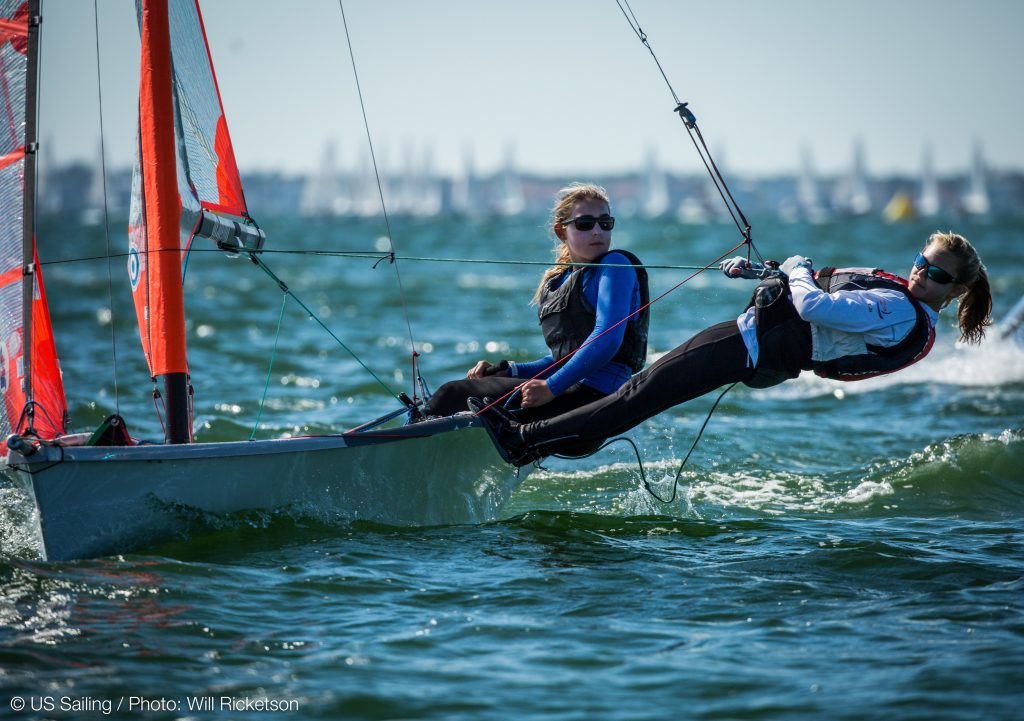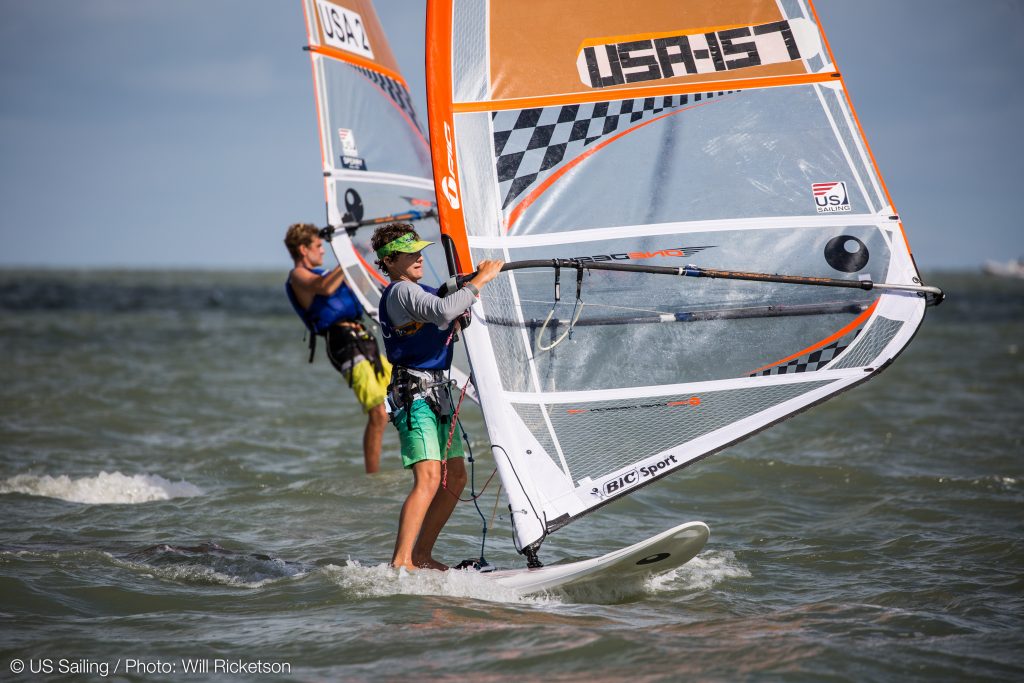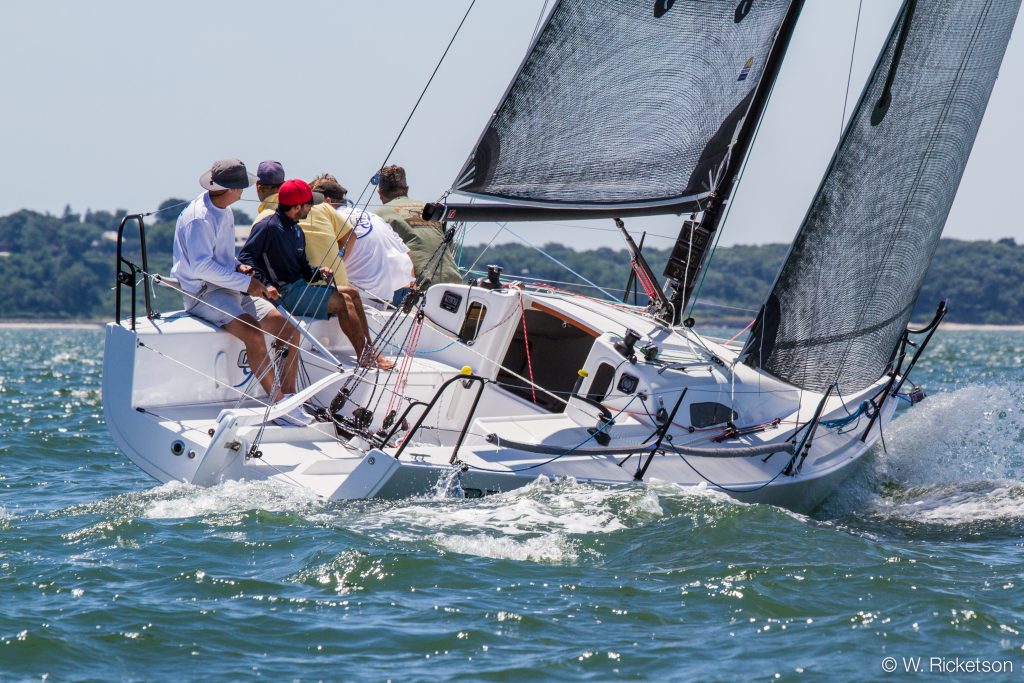
By John Pearce, Youth Director, US Sailing
With Opti Team Trials over, and the high school sailing season winding down, many youth racers are considering the question, what’s next? Sailing is a sport with almost unlimited options, from day sailing to offshore passages, dinghies to schooners, skiffs to cats, kiting, foiling… the list goes on. What a great time to be a sailor.
Many young racers spend a bulk of their time digging into the super popular, highly structured formats that the Optimist fleet and high school sailing provide; and with good reason. Challenging competition is plentiful, there’s a well-defined format that progresses from the regional to the national level, and lots of other kids to socialize with and form lasting friendships. But what should a young sailor look for when they spread their wings in the wider world of sailing? Here are a few thoughts:
Try Crewing
For “graduating” Opti sailors, the prospect of shifting their focus from a singlehanded to a doublehanded class is exciting, but can also be intimidating. With so many classes to choose from, and the challenge of finding a sailing partner who is a good fit, it can feel like you’re trying out a whole new sport. But here’s a shortcut: learn the ropes as a crew in whatever boat you can get your hands on (Club 420, International 420, 29er, etc), and find a more experienced skipper to sail with who you can learn from. Many, many great sailors have learned their craft by crewing for other, more experienced sailors. Rather than reinventing the wheel, you’ll be able to soak up proven skills from your partner and make big jumps up the learning curve.
Kimberly Leonard, 2017 C420 North American, US JR Champs, and Ida Lewis Trophy Champion, had a dominant year in the Club 420. She sees the need for more young sailors to try crewing. “I have news, crews matter! A good crew is hard to find, as is a good skipper. There is always a shortage of crews! Often times many Opti sailors see the stigma behind crewing and turn away. Crews aren’t necessarily bad skippers! The best crews are ones who know how to skipper, it’s important to understand the mechanics behind both jobs. A good crew knows how the skipper thinks and vice versa.”
“Depending on your age and what place you’re at in your sailing career you may be just ending your Opti career or thinking ahead, it seems stressful, but once it works out, you’ll love it. Yes, finding a successful partnership is hard. Sometimes, it works best when you’re not sailing with your friend. Find someone who you work well with, someone who is equally as competitive as you are and has the same drive. Once your personalities are compatible, everything else will come naturally. You’re not going to win every regatta, it’ll take time, you’ll figure out what you like and what they like. You will spend way more time with them than anyone else, sometimes you’ll get annoyed but once you find success, it’ll all be worth it.”
Try Big Boats
As a youth sailor, it’s likely that dinghies are your main thing. But you aren’t a complete sailor unless you know your way around a big boat. Simple skills like loading a winch, securing dock lines, setting an anchor, or reefing a sail can open doors to bigger opportunities in big boat racing and coastal and offshore sailing. Learn these skills now, and you may find yourself sailing a distance race or across an ocean one day.
It may take a little effort to find a local big boat to learn the ropes on, but you’ll probably be surprised by how many boat owners are excited to help get you out on the water and up to speed. Try contacting your local racing fleet, or ask a local sailing coach or program director if they have any suggestions. If you’re program is looking to include big boat sailing in their curriculum, US Sailing’s Junior Big Boat Program Guide is a turnkey option:
US Sailing’s Junior Big Boat Program Guide
Another great resource for learning safety and seamanship skills is the Storm Trysail Foundation’s Junior Safety at Sea seminar series. There are eight seminars taking place across the country this summer. Check it out:
Storm Trysail Foundation’s Junior Safety at Sea schedule
Try Windsurfing
Leandro Spina, US Sailing’s Olympic Development Director, captured some epic footage of American youth sailors at the Techno293 and RS:X South American Championships in Peru this February. It’s hard not to get stoked when you see the speed, balance, and grace of these simple racing machines.
“I think every sailor, regardless of what they want to do with sailing, should experience windsurfing and what those kids are doing in that video” says Spina. “Recreational, competitive, C420, 470, Nacra or Laser, keelboat, all sailors need to windsurf. It is the most organic way of sailing, period, nothing teaches more about balance than windsurfing.”
The raw skills learned through windsurfing, such as feel, power, balance, and using apparent wind to sail faster than the true wind, transfer directly to other fast sailing disciplines such as skiffs, multihulls, and foilers. Whether you’re striving for success at the high performance level, or simply want to sail as fast as possible, windsurfing is a gateway to those opportunities. It’s also one of the most economical sailing options, with one-design equipment like the Techno293 offering a range of sail sizes for sailors as they grow (similar to the Laser 4.7, Radial, and Full Rig), as well as abundant used equipment of all types as a cheap starting point. And with the emergence of foiling boards, windsurfing remains at the forefront of speed and technology.
Race With, and Against, Adults
As a serious youth racer, you may travel far and wide to find the best competition to race against. The big youth regattas around the country draw hundreds of participants, and are very well organized. But, if you want to challenge yourself and improve as a racer, the best opportunity may be right under your nose.
In every part of the country, there are seasoned adult racers who are better than you. That’s a fact. If you want to be the best sailor you can be, find them, and race with them. For example, you might be able to crew for on a Thistle, Lightning, Viper 640, Snipe, J-boat, Etchells… (the list goes on), alongside proven champions who have forgotten more about sailing than you know. Figure out who the best sailors in your area are, and ask if you can sail with them. Bring a notebook, ask questions, and watch your knowledge and ability skyrocket.
Or, if you dare, rig up a Laser, RS Aero, Sunfish or Melges 14 and see if you can beat the old guys. I promise you there’s someone out there who will teach you a thing or two. Old sailors are good! They may have sore knees and grey hairs, but they still know how to get around the race course like it’s 1995. If you can win your club or regional championship against the old timers, you’re well on your way to success at the top levels of the sport.


